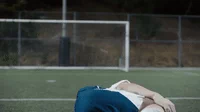For young
athletes, sport specialization means increased risk of injury
Kerry Benson, Brown University
 A new study finds
that kids who specialize in a chosen sport tend to engage in higher levels of
vigorous exercise than their peers and may be more likely to sustain injuries,
such as stress fractures, tendinitis and ACL tears.
A new study finds
that kids who specialize in a chosen sport tend to engage in higher levels of
vigorous exercise than their peers and may be more likely to sustain injuries,
such as stress fractures, tendinitis and ACL tears.
The findings, which draw from a
multi-year, ongoing study of 10,138 older children and teens living throughout
the United States, suggest that volume of vigorous activity is a strong
predictor of injuries for both boys and girls. In other words, those who engage
in the most hours of intense activity per week are the most likely to be
injured.
“It’s wonderful for a child to love a sport and to want to engage in it, but we must keep in mind the number of hours spent playing,” said study author Alison Field, a professor of epidemiology and pediatrics at Brown University. “They add up pretty quickly.”
She hopes the study’s conclusions
will help coaches, parents and doctors guide young athletes toward less
intense, less specialized training.
This study, published in the
Orthopaedic Journal of Sports Medicine on Wednesday, Sept. 18, helps to explain
some of the dangers of sports specialization. Athletes who focus on one
particular sport tend to practice more frequently and intensely compared to
athletes who do not.
“But if we send out a message that
says kids shouldn’t specialize, the worry is that parents and kids will just
add another sport on top,” Field said. “So they’ll keep their current sport and
do it at a very high level and just add one more sport so they’re not
‘specializing.’ That would really increase their volume, so it probably would
not be a good idea.”
Instead, Field said the best recommendation
is to moderate the amount of time young athletes spend engaging in vigorous
physical activity — and if they must specialize in a sport, replace some of
their training with different forms of exercise, such as yoga and
conditioning.
Field said a common fear among
parents is that if their children don’t play more and more, they’ll fall behind
in their sport and won’t ultimately be as good of an athlete.
“But it may actually be the
opposite,” she said. “If children do too much, they may get injured and fall
behind. And it’s important also to remember that they should enjoy doing their
sport; it should be something that doesn’t overwhelm their life.”
The study also suggests that sports
specialization carries risks even when considered separately from volume of
activity. These risk patterns differed for girls versus boys.
For girls, once volume was accounted for, no particular sport stood out as being extra risky to specialize in. However, specialization in general increased girls’ risk of injury by about 30 percent.
For girls, once volume was accounted for, no particular sport stood out as being extra risky to specialize in. However, specialization in general increased girls’ risk of injury by about 30 percent.
In contrast, specialization in
general did not significantly increase boys’ risk of injury, once volume was
accounted for. But certain sports — baseball or gymnastics/cheerleading — did increase
their risk.
Field said the precise reasoning behind
the gender differences in risk is not yet clear, but it’s an area the
researchers hope to explore further in future studies. For girls in particular,
they also plan to examine age-related differences.
“There’s been a lot of concern about
females having higher risk of certain injuries,” Field said. “The question is:
Is that risk highest just as they’re going through their pubertal growth spurt,
and then does it come back down a bit? And then we need to talk to coaches and
trainers and say, ‘What can we do to mitigate that risk?’”
Other authors on the study include
Dr. Frances A. Tepolt, Daniel S. Yang and Dr. Mininder S. Kocher. The study was
funded by the National Institutes of Health (MH087786, DK59570, DK46200,
HL68041 and HD049889) and the Department of Orthopedic Surgery, Boston
Children’s Hospital.
This news story was authored by
contributing science writer Kerry Benson.